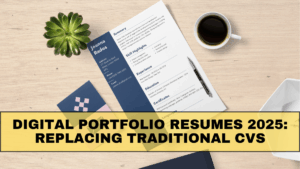In 2025, the hiring landscape is undergoing a significant transformation as Digital Portfolio 2025 becomes the preferred method for showcasing skills and experience. Traditional resumes, often limited to one or two pages, are giving way to dynamic online portfolios that allow candidates to present their work in a more interactive and detailed format. Employers are increasingly valuing visual proof of expertise, project achievements, and multimedia presentations over conventional text-based resumes.
Digital portfolios provide a comprehensive view of a candidate’s abilities, combining professional history with work samples, certifications, client testimonials, and even short videos. This shift is particularly evident in creative fields such as design, marketing, content creation, and software development, but corporate, academic, and technical sectors are also embracing portfolios as a hiring standard.

Why Digital Portfolios Are Replacing Traditional CVs
One of the primary advantages of digital portfolios is the ability to provide tangible proof of skills. Employers can assess a candidate’s actual work, projects, and problem-solving abilities rather than relying solely on written descriptions. This transparency reduces hiring risks and accelerates decision-making.
Additionally, digital portfolios offer interactivity and multimedia support. Candidates can include links to websites, GitHub repositories, design mockups, presentations, and even embedded videos. This creates a richer narrative and allows recruiters to engage with candidates more effectively.
Key Features of a Modern Digital Portfolio
Digital portfolios in 2025 often include:
-
Work Samples: Real projects, case studies, designs, or software code to demonstrate practical skills.
-
Multimedia Elements: Videos, infographics, and slides that provide dynamic context.
-
Certifications & Credentials: Verified proof of training, degrees, and skill development programs.
-
Testimonials & References: Feedback from clients, managers, or peers to showcase credibility.
-
Interactive Design: Easy navigation, mobile compatibility, and visually appealing layouts.
These features not only highlight expertise but also improve the candidate’s online presence, which is increasingly considered by employers.
Benefits for Job Seekers and Employers
For job seekers, digital portfolios provide a competitive edge by demonstrating creativity, initiative, and a professional approach. They allow candidates to stand out in highly competitive markets, especially for roles where practical skills are critical.
Employers benefit from faster and more informed hiring decisions. Digital portfolios reduce the need for extensive interviews or technical tests in early stages, allowing recruiters to filter candidates based on actual performance and capability. The result is a more efficient and accurate recruitment process.
How to Create an Effective Digital Portfolio
A strong digital portfolio should be concise yet comprehensive. Candidates should focus on quality over quantity, ensuring work samples are relevant and updated. Using platforms like personal websites, LinkedIn, Behance, or GitHub can provide the necessary visibility. Attention to layout, ease of navigation, and professional presentation is crucial.
Additionally, integrating analytics to track views or engagement can provide insights into which sections attract recruiters’ attention, helping candidates refine their portfolios for maximum impact.
Conclusion
Digital Portfolio 2025 is revolutionizing the job application process by replacing traditional CVs with interactive, detailed, and proof-based presentations. As companies prioritize practical skills and real-world accomplishments, candidates who invest in well-structured digital portfolios will have a significant advantage in the hiring process. These modern portfolios not only demonstrate competence but also enhance professional visibility and credibility in today’s competitive job market.
FAQs
What is a digital portfolio?
A digital portfolio is an online collection of a candidate’s work, projects, certifications, and multimedia content showcasing skills and experience.
How is it different from a traditional resume?
Unlike a one-page CV, a digital portfolio offers interactive elements, work samples, videos, and detailed project demonstrations.
Which professions benefit most from digital portfolios?
Creative fields, IT, marketing, content creation, design, and roles requiring proof of practical skills.
Can digital portfolios improve hiring chances?
Yes, they allow employers to assess real work and reduce hiring risks, giving candidates a competitive edge.
How can I create an effective digital portfolio?
Focus on relevant work samples, multimedia content, certifications, testimonials, and use platforms like LinkedIn, Behance, GitHub, or personal websites.
